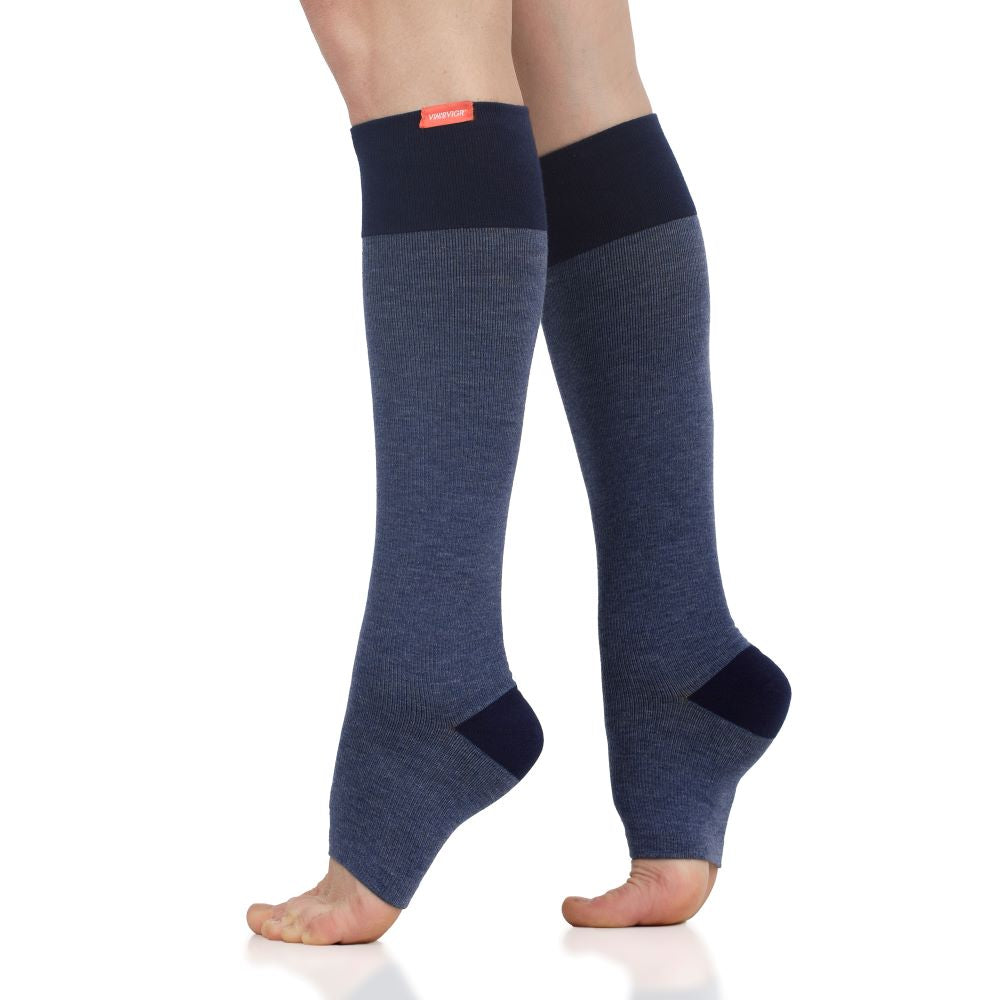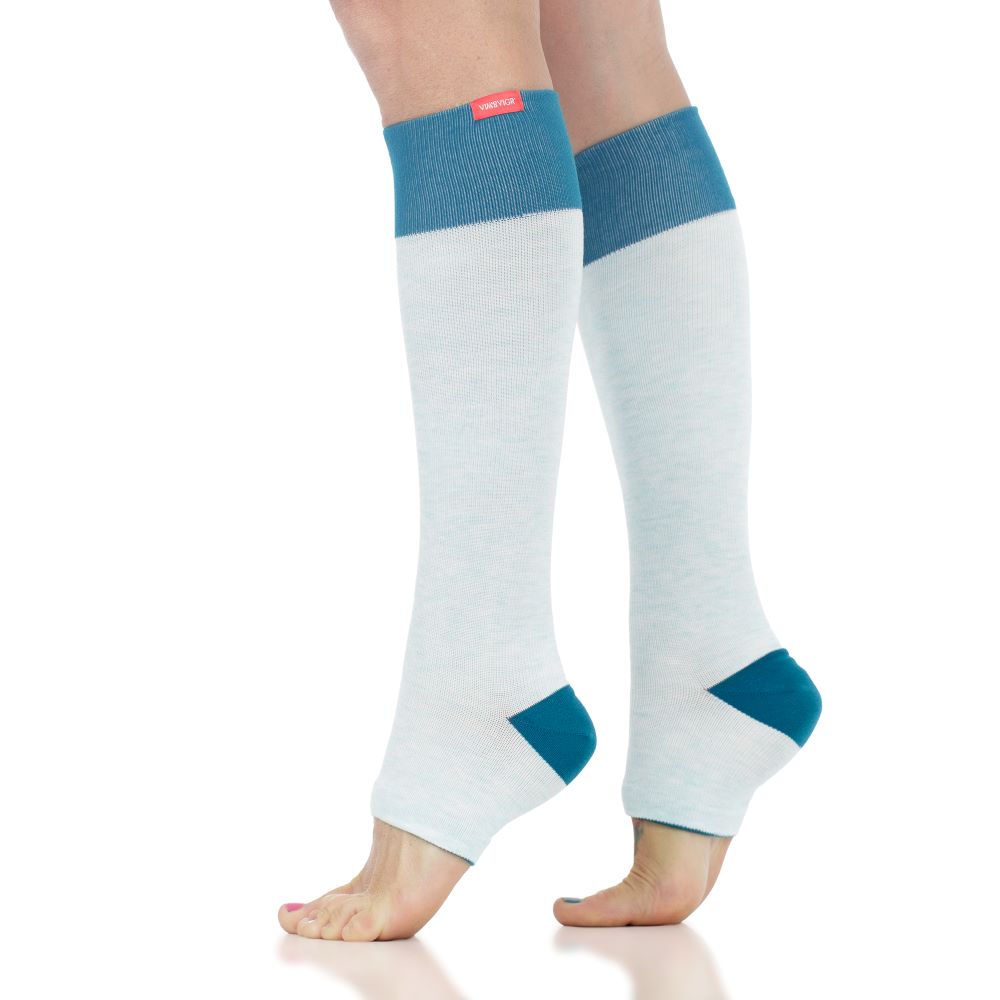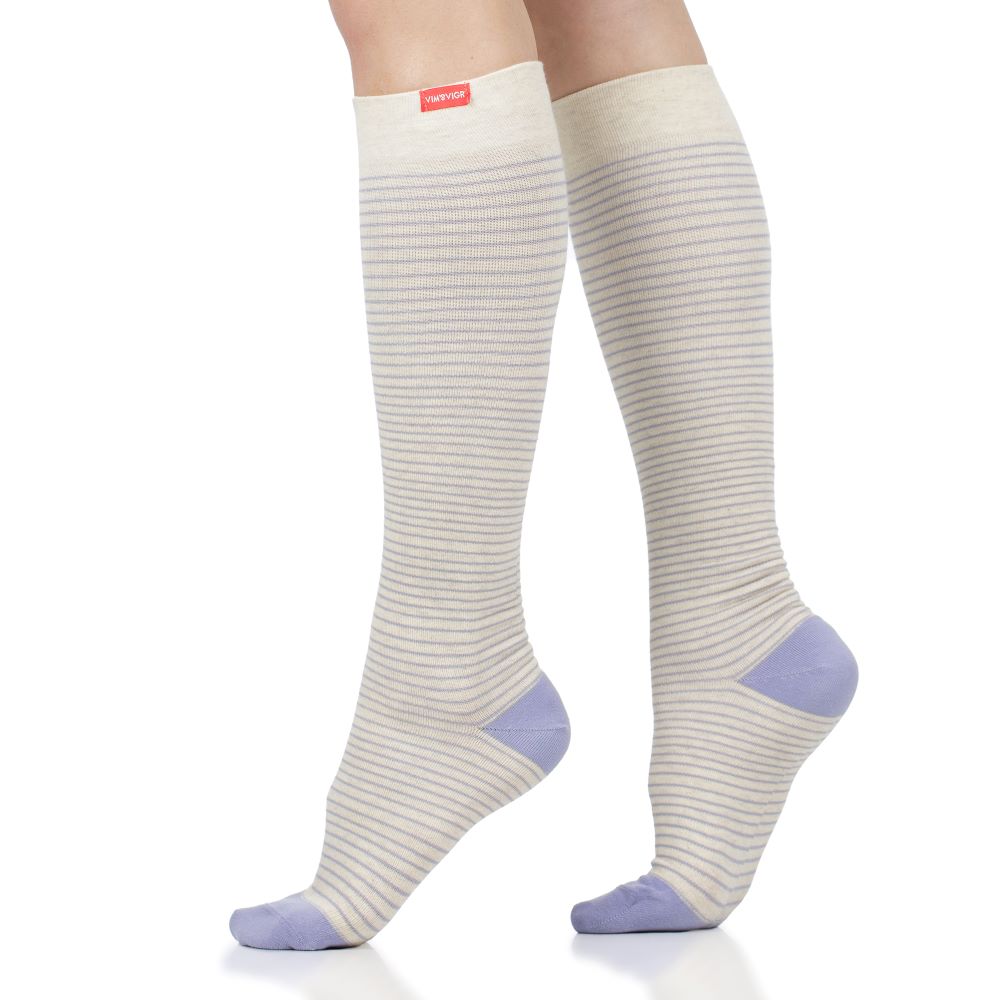
Open Toe Compression Socks
Written By Alecsa Stewart
Scientifically Reviewed by Daniel Chantigian
Toeless compression socks, also known as open toe compression socks, are a great way to diversify your compression wardrobe so you can match your outfits or give your toes a breather when they need it. Many fans of our compression socks use the toeless version to help boost circulation and reduce swelling without hampering their summer style. Alternatively, if you have sensitive feet and toes, but still want to benefit from a lower limb blood flow boost, toeless compression socks are the best option for those with sensory issues.
What are Toeless Compression Socks?
The obvious difference between regular and toeless compression socks is the missing material that covers the toes. Otherwise, just like normal compression socks, toeless compression socks are therapeutic garments that apply pressure to the lower legs to boost circulation, reduce swelling, and soothe the muscles. At Vim & Vigr, our open toe compression socks are also graduated, which means they are tighter at the ankles and gradually release pressure towards the knee. We use graduated compression because clinical research found that this compression style improves blood flow.
Graduated open toe compression stockings or socks offer the same benefits of compression as normal compression socks, but they give you the flexibility of choosing stylish open-toed footwear.
The Benefits of Toeless Compression Socks
There are multiple benefits of graduated compression socks, as per scientific and medical research. These include:
-
Improved blood flow - research shows graduated compression socks can increase the venous blood flow by about 24% in the lower legs.
-
Better comfort levels when standing or sitting all day at work, particularly by preventing or reducing swelling by up to 50% according to some research findings.
-
Preventing blood clots and more serious conditions such as deep vein thrombosis (especially after surgery).
-
Relieving pressure on the venous system from gravity (standing for long periods of time).
-
Improved energy levels and less feelings of heavy legs.
-
Better athletic performance and quicker recovery.
In addition to the circulatory benefits, wearing open toe socks helps individuals who need to have their toes uncovered, but still want the benefits of compression. The toeless compression sock design is great for people with sensory problems or for those who have an infection or injury around their toes or on their toenails.
Finally, you may simply be looking for a stylish compression solution that matches your summer outfits and footwear! Our fashionable toeless socks bring a pop of color and interesting designs to your outfits; while allowing you to stay stylish and enjoy wearing sandals so you can show off that pedicure.
When to Wear Toeless Compression Socks
You can wear open toe compression socks to gain the benefits of compression while keeping your toes uncovered all year round. The most popular scenarios for wearing your toeless compression socks are listed below.
Travel and Long Flights
When you’re traveling in hot weather, you will want to limit swelling from long periods of time spent sitting, and wearing a toeless pair of compression socks is an easy, natural way to reduce the risk of swelling. Your open toe socks will continue to apply pressure to the lower extremities, helping with venous return and preventing blood from pooling around the ankles.
On long flights, people often end up sitting for long periods of time without moving their legs. This leads to swelling, discomfort, and even feelings like “pins and needles.” During long flights, more severe issues with circulation can occur like painful edema or deep vein thrombosis (DVT). In fact, this clinical report found that flying for over 3 hours increases your risk of developing DVT by 70%. However, wearing compression socks significantly reduces this risk. One report stated that populations at a high-risk for developing DVT are 10 times less likely to develop it when wearing compression socks when flying.
Open toe compression socks let you wear your favorite pair of sandals on that economy class flight while giving you the peace of mind knowing that you will avoid experiencing painful symptoms of leg swelling or DVT.
Standing or Sitting all Day
Gravity pushes down on the lower leg veins, which can lead to blood having a hard time traveling back up to the heart. This is why professions like nursing, teaching, or construction are often full of people who struggle with peripheral circulation. However, wearing compression socks or stockings can really help reduce the side effects of all-day standing and may even boost energy levels and wellbeing, too.
Warm Weather Activities
If you have a medical condition linked to poor circulation or are struggling to keep your feet from swelling, you will love the way knee-high compression socks support your blood flow and reduce the negative symptoms. However, you may find them a little uncomfortable in warm weather. Even our most breathable fabrics like merino wool are sometimes too much! Luckily, you can continue to enjoy the benefits of compression in warm weather by switching to an open toe pair of compression socks or stockings.
Pregnancy and Swollen Feet
Doctors often recommend compression stockings to help pregnant women maintain good blood flow throughout the body and prevent blood clots and varicose veins during this time. One study found that wearing compression socks throughout pregnancy reduces swelling by 80-90%. While you are pregnant, you may still want to wear flip flops and summer dresses, so opt for toeless compression to suit your style and improve your comfort. The boost in blood flow will keep your feet from swelling, all while letting your toes breathe.
Managing Edema and Swelling
If you suffer from frequent swelling in the lower limbs, you could be dealing with poor peripheral circulation where the blood pools around the ankles. You may also have lymphedema, where lymph fluid seeps into the tissues around the lower legs and causes swelling. For either case, compression socks reduce swelling by improving circulation to keep fluid from pooling in the lower legs and give your lower legs a welcome, soothing massage. Open toe socks do all this while allowing your toes to be free from any pressure.
Supporting Diabetic Foot Health
Diabetics benefit from the blood flow boost offered by compression socks, while also getting added protection for the sensitive skin on their lower legs. Diabetic compression garments help prevent swelling and blood clots. They also cover the legs, reducing the risk of ulcers and infections. By choosing a toeless pair, you are letting your toes breathe and allowing quick access to any infected or injured area around the feet or toes.
Relief for Varicose Veins and Venous Insufficiency
Compression socks are effective in reducing swelling and leg fatigue, supporting the venous system, and relieving patients of pain and discomfort caused by varicose veins. This research report found that people that wear compression socks have improvements in symptoms caused by varicose veins. While compression socks can reduce pain and swelling, they also relieve some of the pressure that your body is putting onto the damaged veins. This helps improve circulation and your overall well being.
How to Choose Open Toe Compression Socks
Thanks to our toeless compression socks collection, you can enjoy the benefits of compression while staying stylish and letting your toes breathe. If you still have any doubts about how to pick the best pair for you, here are some quick pointers.
Understanding Compression Levels
It is important to understand that not all toeless compression socks exert the same level of pressure on your limbs. We carry three categories:
-
15-20 mmHg, which is the lightest compression level that is still effective for boosting blood flow and reducing the risk of swelling, pain, and blood clots. These can be worn all day long with no issues.
-
20-30 mmHg, which is effective compression for those who have a medical condition linked to the circulatory system, or for athletes looking for quick recovery and for professions that need to stand for long periods of time.
-
30-40 mmHg, for medical prescriptions only.
Choosing the Right Size
To ensure you get the most out of your toeless compression socks, always ensure you are wearing the best size. We recommend that you measure your calf circumference and map that against your shoe size on the product page you’re trying to buy or here. This will allow you to avoid socks that roll down or are ineffective.
Another important aspect of wearing compression socks is putting them on the correct way. Be sure to check out this guide to show you how to put on open toe compression socks to prevent you from damaging the material and to let you maximize the benefits of wearing toeless compression socks.
References
Charles, T., Mackintosh, D., Healy, B., Perrin, K., Weatherall, M., & Beasley, R. (2011). Merino wool graduated compression stocking increases lower limb venous blood flow: a randomized controlled trial. Advances in therapy, 28(3), 227–237. Read it here.
Partsch, H., Winiger, J., & Lun, B. (2004). Compression stockings reduce occupational leg swelling. Dermatologic surgery: official publication for American Society for Dermatologic Surgery [et al.], 30(5), 737–743. Read it here.
Sachdeva, A., Dalton, M., & Lees, T. (2018). Graduated compression stockings for prevention of deep vein thrombosis. The Cochrane database of systematic reviews, 11(11), CD001484. Read it here.
Armstrong, S. A., Till, E. S., Maloney, S. R., & Harris, G. A. (2015). Compression socks and functional recovery following marathon running: a randomized controlled trial. Journal of strength and conditioning research, 29(2), 528–533. Read it here.
Adi, Y., Bayliss, S., Rouse, A., & Taylor, R. S. (2004). The association between air travel and deep vein thrombosis: systematic review & meta-analysis. BMC cardiovascular disorders, 4, 7. Read it here.
Clarke, M. J., Broderick, C., Hopewell, S., Juszczak, E., & Eisinga, A. (2021). Compression stockings for preventing deep vein thrombosis in airline passengers. The Cochrane database of systematic reviews, 4(4), CD004002. Read it here.
Saliba-Júnior, O. A., Rollo, H. A., Saliba, O., & Sobreira, M. L. (2022). Positive perception and efficacy of compression stockings for prevention of lower limb edema in pregnant women. Jornal vascular brasileiro, 21, e20210101. Read it here.
Knight Nee Shingler, S. L., Robertson, L., & Stewart, M. (2021). Graduated compression stockings for the initial treatment of varicose veins in people without venous ulceration. The Cochrane database of systematic reviews, 7(7), CD008819. Read it here.




















